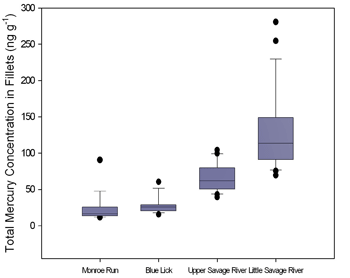Although many low order streams in the Allegheny Plateau of western Maryland drain relatively undeveloped watersheds, they receive some of the highest wet deposition of mercury in the United States. These high mercury loads may enhance mercury concentrations in native brook trout. Yet fish consumption advisories issued by Maryland's Department of Natural Resources have been limited to warm- and cool-water fish species. In addition to high mercury loadings, some small streams in the region drain naturally occurring high-elevation wetlands. These streams are especially at risk because high loads of atmospheric mercury deposition to these wetlands may enhance mercury accumulation in native brook trout. Wetlands can be sources of methylmercury to downstream ecosystems.
This project, funded by the Maryland Department of the Natural Resources, was designed to determine if wetlands influence mercury concentrations in brook trout, benthic macroinvertebrates, and surface water.
We studied four streams in western Maryland with varying amounts of wetlands in their watersheds that support native, self-sustaining populations of brook trout. The watersheds of two streams, Blue Lick and Monroe Run, did not contain wetlands. The other two streams, Upper Savage River and Little Savage River, drain wetlands to varying degrees. The Upper Savage River watershed contains 61 ha wetlands (3% of the watershed area), starting 10,200 meters upstream of our sampling sites. The Little Savage River watershed contains 35 ha wetlands (7% of the watershed area) starting 3800 meters upstream of our sampling sites. Locations of the sampling sites are shown in the figure to the left.
We collected water, sediment, benthic macroinvertebrate, and brook trout samples in the fall of 2005. We continued to monitor surface water chemistry in late 2005 and early 2006. Water and tissue samples were analyzed for both total mercury and methyl mercury using EPA-approved techniques.

Results from stream water analysis were comparable to concentrations observed in the literature. Little Savage River had 3 to 5 times higher total mercury concentrations than the other streams with a much greater percentage of this total mercury in particulate form. Little Savage River also had the highest methylmercury concentrations.
We found significantly (p = 0.05) higher average total mercury concentrations in brook trout from Little Savage River; intermediate concentrations in fish from Upper Savage River; and lowest concentrations in brook trout from Blue Lick and Monroe Run (see figure at right). Although mercury concentrations were higher in the wetland watersheds, none of the brook trout in our study exceeded the FDA, EPA, or MDE's fish mercury consumption criteria.

